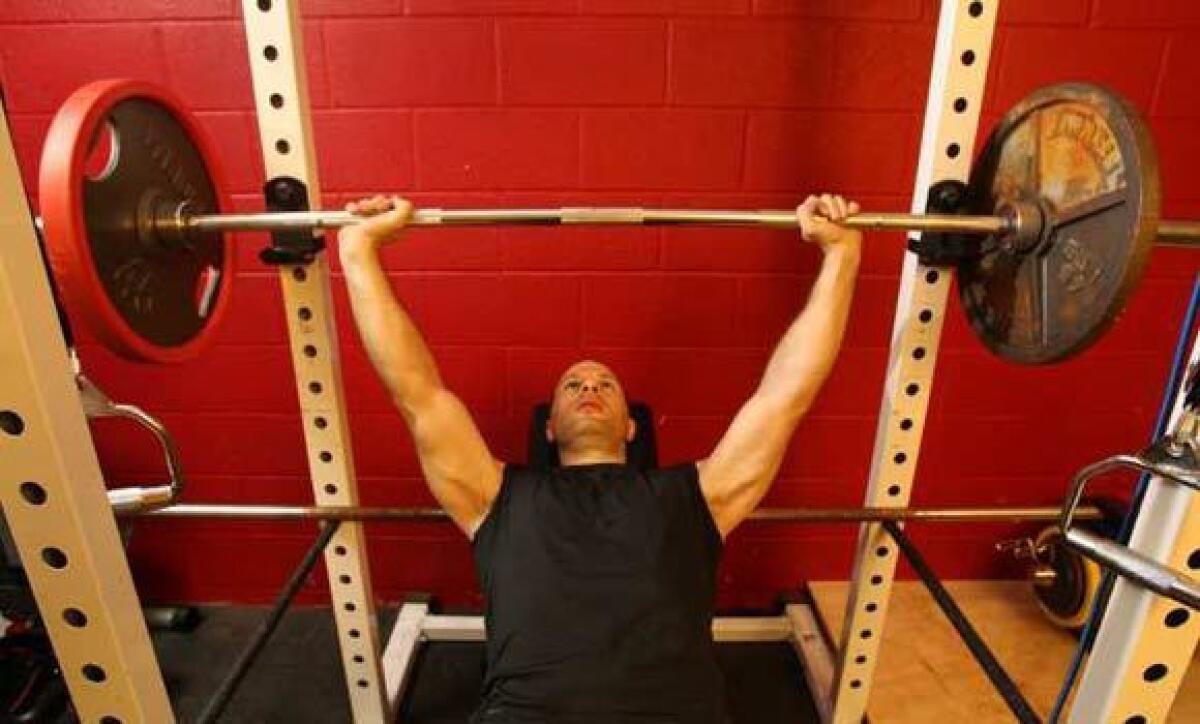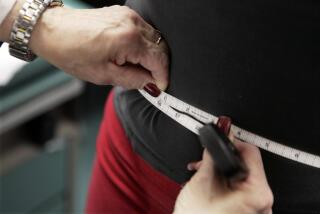Patients kick the insulin habit through diet, exercise

- Share via
By harnessing the power of lifestyle, the following people are managing their Type 2 diabetes without insulin, and in some cases without any medication at all. Some made the commitment when they were first diagnosed, but others reversed a condition that had been spiraling downward for years. Here’s how they did it:
“I’m controlled, not cured, but I’m not going back.”
Aaron Snyder, San Diego
Age: 31
Occupation: Commodities analyst for Shell Oil
Diagnosed: 10 years ago. (Diabetes is diagnosed by a fasting blood sugar of higher than 126 and an A1C of 6.5 or higher.)
Weight then: 220 pounds
Height: 5 feet 6
Background: “I was a math major at UC Berkeley and the pressure was enormous. I solved a lot of problems with food.” One evening, after he went out to dinner with a diabetic friend, she tested his blood sugar out of curiosity. It was 215. His A1C was in the 7s. “I had a long family history of diabetes; I just never thought I’d be part of it.”
Lifestyle changes: Over the next year he lost 50 pounds on a low-carb diet, and 10 more pounds the year after that. His doctor put him on insulin and metformin, a non-insulin medication that decreases the liver’s output of sugar and boosts cells’ ability to metabolize insulin. He began exercising daily.
Today: He still weighs 160 pounds, and sticks to his low-carb diet. Two years ago, he stopped taking all his diabetes medications, and his blood pressure and cholesterol are normal. He works out every day, lifting weights four days a week, and riding a stationary bike 30 minutes three days a week.
Advice: “I wish people understood that what you eat now influences what you want to eat next. A low-carb diet is the best way to curb your appetite and maintain your weight.”
What keeps him on track: His great grandmother had a stroke and lost a leg to diabetes, and his grandfather went blind and died of kidney disease, also due to diabetes. Besides, he adds, “I like how I look now, and more important, how I feel.”
“I went from eating frequently from the vending machine to knowing where all the yoga classes and running trails are around town and shopping at the farmers market.”
Howard Yosha,
Laguna Hills
Age: 37
Occupation: Cable consultant for Time Warner Cable
Diagnosed: Six years ago
Weight then: 240 pounds
Height: 5 feet 8
Background: While working at a communications call center, Yosha developed gout in his legs and feet, which triggered a toe infection that wouldn’t heal. His doctor suspected diabetes. Tests revealed his blood sugar was 415 and his A1C was approaching 13. His doctor started him on Actos, a drug that helps reverse early diabetes and increase the body’s sensitivity to insulin. He put Yosha on a 1,400-calorie diet and sent him to a hospital-sponsored class.
Lifestyle changes: He took the six-week class “very seriously,” he said. He made losing weight a priority, joined e-diets and downloaded hundreds of healthy recipes. “I learned to cook and shop at the local farmers market.” He got on a strict schedule, and programmed his Palm Pilot to sound every time he was supposed to sleep, eat, check his blood or take his meds. He started walking 2 miles at lunch and after work. He eventually lost 65 pounds and started taking yoga.
Today: He’s medication-free and weighs 175; his A1C is 5.2 and his blood sugar stays around 98. He eats and sleeps at the same time every day. He takes two to four yoga classes a week and walks or jogs 2 to 8 miles a day. Last December, his employer sponsored him to run the O.C. half-marathon. He ran the 13-mile race again in May.
Advice: “Make moving more [of] a habit. I park on the top floor of my office’s parking structure . . . and I pick the farthest parking space at the shopping center.”
What keeps him on the program: “I will do anything to avoid that terrible foot pain I had. I had uncles lose limbs to diabetes. I never want that to happen to me.”
“Don’t underestimate the body’s potential to heal on its own.”
John Burgess, Irvine
Age: 43
Occupation: Accountant
Diagnosed: 18 years ago
Weight then: 220 pounds
Height: 5 feet 11
Background: For a long time Burgess controlled his disease with diet and exercise, but eventually he needed medication. He started taking metformin and Actos, and ultimately, in July 2007, insulin, which caused weight gain. By December 2008, he weighed 250, had become more insulin resistant and needed medications to manage blood pressure and cholesterol. His sedentary job didn’t help. He ultimately needed the strongest insulin available, five injections a day of U-500. In six months he gained 50 more pounds, peaking at 305. In July 2009, he saw Dr. Wei-An Lee.
Lifestyle changes: Lee put Burgess on a strict, 700-calorie-a-day diet. One week later he was off all insulin. After two weeks, he graduated to a 1,000-calorie diet, and added some exercise. He got a pedometer and aimed for 5,000 steps a day. He lost 84 pounds in 85 days. All his numbers, which he charts meticulously, have improved.
Today: He weighs 211 pounds, has dropped eight prescription meds in three months, including all his diabetes medications, two blood pressure medications, and medicine for his triglycerides. He’s halved his cholesterol medication. He does 5 1/2 miles a day on the elliptical and sometimes runs an additional half a mile on the treadmill, for a total of 6 miles. He focuses on carb control and relies on Lean Cuisine. “Last summer I couldn’t walk 100 steps; now I’m jogging.”
Advice: Because taking clients to lunch is part of his job, he looks at the restaurant’s menu online and when possible, the nutritional content of certain dishes, so he can decide in advance what to order. If he can’t get the nutritional information, he orders meat and vegetables.
What keeps him on track: Results. “The program sounds drastic, but sticking with it is easy when you understand the payoffs.”
“I’ve had plenty of Ben & Jerry’s Ice Cream, plenty of cocktails; now I just want to live.”
Louise Valenciana,
La Puente
Age: 55
Occupation: Unemployed, former school principal, teacher
Diagnosed: 13 years ago
Weight then: 242 pounds
Height: 5 feet 2
Background: When first diagnosed, Valenciana got serious about her weight and lost 45 pounds. She put her diabetes on the back burner, however, after a bout of cancer -- a stage 2 tumor in her leg that required surgery and 10 months of chemotherapy -- followed by a heart scare that resulted in doctors putting in two stents. In 2004, when her doctors saw that her blood sugar was 416 and her A1C was more than 13, they put her on insulin and metformin. “I was a mess -- cancer, diabetes, heart disease. I finally stopped telling myself I would deal with this later.” In February, she started seeing a new doctor, who put her on a 600-calorie diet. She learned to like fruits and vegetables and stopped skipping meals. Her reward came one month later: She got to go to McDonald’s, where she can still go, but only if she orders as prescribed -- 3 ounces of chicken, and a green salad. And she started walking every day.
Today: She weighs 189 pounds, and is off insulin. She still takes metformin and medication for high blood pressure, which she hopes to wean herself from as she loses more weight. She also still checks her blood sugar several times a day, and it’s usually less than 100. She tries to maintain a 1,000-calorie diet and walk 40 minutes most days a week, shooting for 6,000 steps a day. And her cancer has been in remission 10 years. “I feel as if a huge weight has been lifted -- literally and figuratively.”
Advice: “Find someone who will help you truly understand your illness. I have two college degrees and didn’t understand how damaging my diet was.”
What keeps her on track: “I didn’t survive cancer to die of diabetes.”
“This isn’t hard. Being on insulin is hard.”
Larry Hagman,
Santa Monica
Age: 78
Occupation: Actor
Diagnosed: Shortly after his much-publicized liver transplant in 1995, the former “Dallas” TV star developed diabetes.
Weight then: 216 pounds
Height: 6 feet 1
Background: People who have organ transplants often develop diabetes as a response to anti-rejection medications. Hagman was giving himself five insulin shots a day. When he realized insulin didn’t have to be part of his life, he made some changes.
Lifestyle changes: He lost 20 pounds, and now weighs 196. He continues his daily diet of eggs, bacon and coffee for breakfast. A Glucerna shake for lunch, and a light dinner of typically either soup and an open-faced ham-and-cheese sandwich, or fish and salad. No alcohol, not after he got his new liver. “Why push it?” He exercises one to two hours a day in his home gym doing free weights, and cardio on the elliptical, or he walks along the ocean. And he gets to bed at a reasonable hour: “As you get older, going to bed is the most fun thing you do all day.”
Today: He takes no insulin and only one pill (Januvia, an incretin that boosts gut hormones) a day. His blood sugar stays in the low 100s and his A1C is 6.4.
Advice: Lose weight. Eat right.
What keeps him on track: “I can’t believe the freedom from not taking shots all the time. I don’t know what to do with all my time.”






